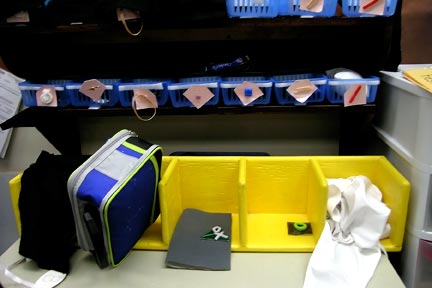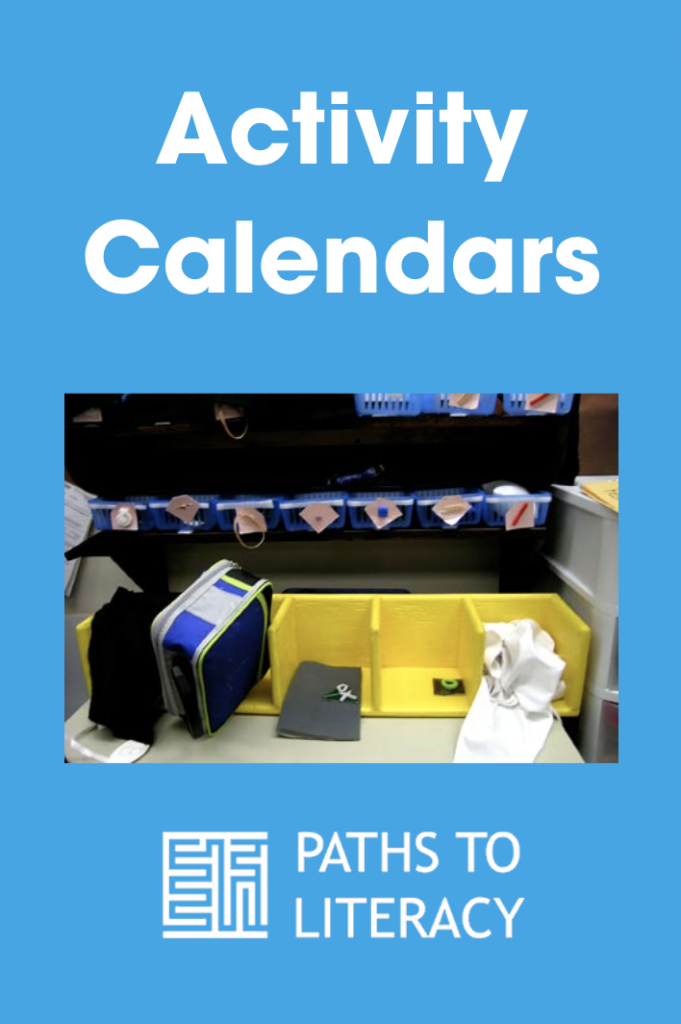Many VI teachers are familiar with the object calendars that are part of the communication methodology developed by Dr. Jan van Dijk for students with deafblindness. The calendar boxes represent time, usually one school day. The objects in the boxes represent the major activities that will take place during the day. Here is an example of a typical daily calendar.

Some students have trouble learning that objects represent activities in this time frame. Sometimes the communicative function of a series of objects can be learned more efficiently when the time frame is shortened to one specific activity. In an activity calendar, the boxes represent the sequenced steps of the activity and the objects represent the event in that step. Here is an example.
Activity: Making Chocolate Milk
| Steps: | Symbol: |
|---|---|
| 1. Pour milk in blender. | Milk carton. |
| 2. Pour chocolate syrup in blender. | Syrup can. |
| 3. Put lid on blender. | Lid. |
| 4. Blend for ten seconds. | Switch. |
| 5. Pour milk in glass. | Glass. |
To begin, the student might take the milk carton out of the first box and pour it directly into the blender. Later, or at first for a higher functioning student, an empty milk carton might be in the first box. In this case, the empty carton would be a symbol for the step of going to get the real milk to pour into the blender. Adapt to ensure success. Do things like putting only the desired amount of milk in the carton so the student doesn’t have to worry about over filling the blender.
Here are some of the communicative things that can happen in this routine.
- The student can ask for help by directing your hand to an object.
- The student can tell you what needs to happen next by getting the appropriate object.
- The student can request chocolate milk by getting one of the objects used in the activity and showing it to you.
- The student can eventually choose between chocolate or some other flavor by putting the desired container in the appropriate box.
- The student can tell you how to make chocolate milk by putting the objects in the boxes in the correct order.
Just as with daily calendars, the object symbols can be made gradually more and more abstract. Instead of the whole milk carton, you might use a piece of the milk carton. Eventually the piece might be mounted on a card with a braille label written on the card. The student should be doing several of the above communicative functions with the actual object used in the activity before you increase the level of abstractness.
Also as with daily calendars, the time or sequence display can be changed. Boxes can be replaced by a carpet strip with yarn dividers. A book format might be used. Carefully control changes. You might not want to change symbol levels and format levels at the same time.
Activity calendars and daily calendars can be used by the same student simultaneously. If a student has a daily calendar and an activity calendar, it might be helpful to have boxes made out of different materials for each type calendar to help make a clear distinction between the functions of each.
Learn more about setting up Object Calendars
- Anticipation Calendars (Texas Deafblind Project)
- Calendar Systems, OHOA Modules, National Center on Deafblindness
- Calendar Systems: A Developmental Approach for Young Children with Sensory Impairments by Mary Tellefson
- Let Me Check My Calendar, by Robbie Blaha and Kate Moss Hurst, Texas School for the Blind and Visually Impaired
- Object Calendars (Nevada Dual Sensory Impairment Project)

This article was originally published by Texas School for the Blind and Visually Impaired (TSBVI) and is reprinted here with permission.



